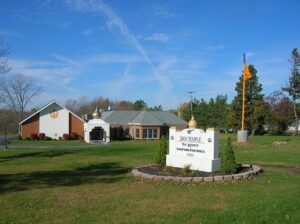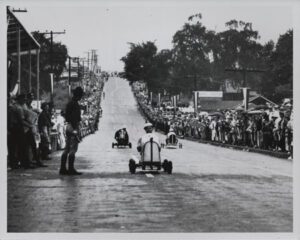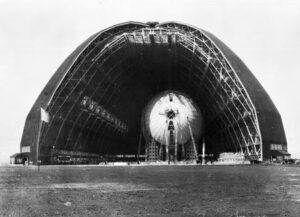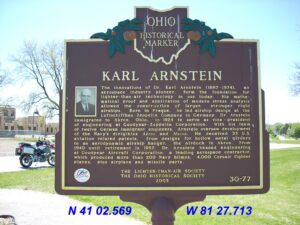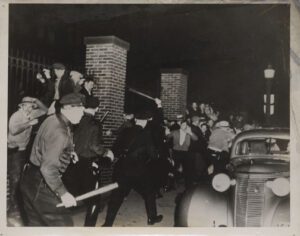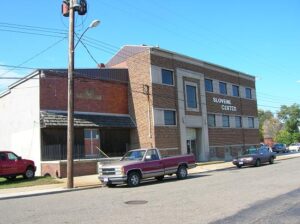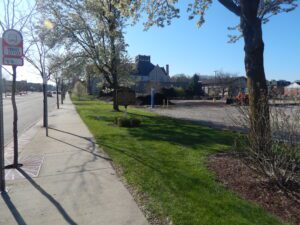, OH
This marks the site of the first Sikh Gurdwara in the state of Ohio. Sikhs began to arrive in Ohio after India’s freedom from British rule in 1947. They came for advanced education at universities in the state. With liberalization of immigration laws in the 1960s, many Sikhs settled in metropolitan areas and set up organizations to hold congregational prayer. The Guru Nanak Foundation of Greater Cleveland Area was named after Guru Nanak, the founder of Sikh Faith. The Foundation, which at first used rental facilities for religious activities, was incorporated in 1976. However, by 1980 it was able to purchase a building at 3305 West 25th Street in Cleveland. Membership swelled during the 1980s, and in 1991 the congregation decided to move the Gurdwara to its present location in Richfield.
, OH
An annual summer tradition for American youth since the 1930s, the All-American Soap Box Derby was the concept of journalist Myron E. (“Scottie”) Scott, who covered an impromptu homebuilt gravity-car race in Dayton in 1933. Scott conceived and promoted a prize-awarding event later that year, and to his surprise 362 boys entered the race. Restrictions on material cost and participants’ ages widened the sport’s appeal; the Soap Box Derby held its first national championship in Akron in 1935, sponsored by the auto and rubber industries. Derby Downs, built as a public works project by the New Deal-era Works Progress Administration (WPA), has been the event’s home since 1936. The Soap Box Derby continues to promote the values of craftsmanship, sportsmanship, and perseverance for generations of American youth.
, OH
A colossus of engineering acumen and structural steel, the Airdock was built in 1929 as the construction facility for the U.S. Navy’s rigid airships, the USS Akron (1931) and USS Macon (1933). The airships, or dirigibles, served as the fleet’s aerial watchdogs, but with the advancement of aircraft carriers, the Navy no longer needed these leviathans of the skies, which were large enough to carry five biplanes. Eleven steel parabolic arches, cresting at 211 feet, create one of the largest open space interiors in the world and shelter more than 364,000 square feet of floor space. Only one of the arches is fixed to its concrete piling. Its 660-ton spherical doors rest on flatbed railroad cars to open. The Airdock, a National Civil Engineering Landmark, was added to the National Register of Historic Places in 1973.
, OH
The innovations of Dr. Karl Arnstein (1887-1974), an aerospace industry pioneer, form the foundation for lighter-than-air technology in use today. His mathematical proof and application of modern stress analysis allowed the construction of larger, stronger rigid airships. Born in Prague, he led airship design at the Luftschiffbau-Zeppelin Company in Germany. Dr. Arnstein immigrated to Akron, Ohio, in 1924 to serve as vice-president of engineering at Goodyear-Zeppelin Corporation. With his team of twelve German immigrant engineers, Arnstein oversaw development of the Navy’s dirigibles Akron and Macon. He received 35 U.S. aviation related patents, from designs for hollow metal girders to an aerodynamic airship hanger, the Airdock in Akron. From 1940 until retirement in 1957, Dr. Arnstein headed engineering at Goodyear Aircraft Corporation, a leading aerospace contractor, which produced more than 200 Navy blimps, 4,000 Corsair fighter planes, plus airplane and missile parts.
, OH
On this site, the first meetinghouse owned by the Hudson Congregational Church was dedicated March 1, 1820, twenty-one years after David Hudson first came to the Hudson area. Its members met here until they completed their sanctuary on Aurora Street in 1865. In August 1835, church members unanimously adopted a resolution declaring that slavery is”a direct violation of the law of Almighty God.” At a November 1837 prayer meeting, church member and anti-slavery leader John Brown made his first public vow to destroy slavery.
, OH
Five Depression-era strikes against many of Akron’s rubber companies culminated in a giant “sit-down” strike against Goodyear Tire and Rubber Company, the industry’s leader, in February and March of 1936. The fledgling United Rubber Workers (URW), created in September 1935, used the tactic of being at work but not working that had been pioneered by rank-and-file workers in a successful 1934 strike against the General Tire and Rubber Company. After a peaceful month-long strike, the URW won recognition from Goodyear and reached a settlement on March 22. The 1936 Akron Rubber Strike was one of the earliest successes for the Committee for Industrial Organization (CIO), sparking a wave of industrial organizing and similar strikes in 1936 and 1937. The “sit-down” strategy extended beyond the rubber industry and was instrumental in the founding of the industrial union movement in the United States.
, OH
In 1918, early Slovene immigrants organized the Slovenian Independent Society Home and later constructed this hall, which became the center for Barberton Slovene cultural, social, and recreational activities. They formed dramatic and singing clubs, conducting performances in their native language. In the early twentieth century, prior to employers providing insurance or health care for their workers, the society acted to ensure sick and death benefits for its members. It also prepared members for citizenship in their newly chosen country. First generation Slovenes provided the labor that helped spur the growth of local industries while succeeding generations have continued to contribute to the community in various business, industrial, professional, and governmental capacities.
, OH
On May 1, 1950, the Akron Community Service Center and Urban League building opened to the public. The Center was a gathering place for African Americans of the community, where they addressed workplace, education, and other issues dividing the city. Directors included the late George W. Thompson, Raymond Brown, and Vernon L. Odom. The Center provided space for meetings, classes and receptions and had a swimming pool and gymnasium. The Center also hosted talent shows, which included the musicians who became Ruby and the Romantics. The group scored a #1 hit in 1963 with “Our Day Will Come.”


